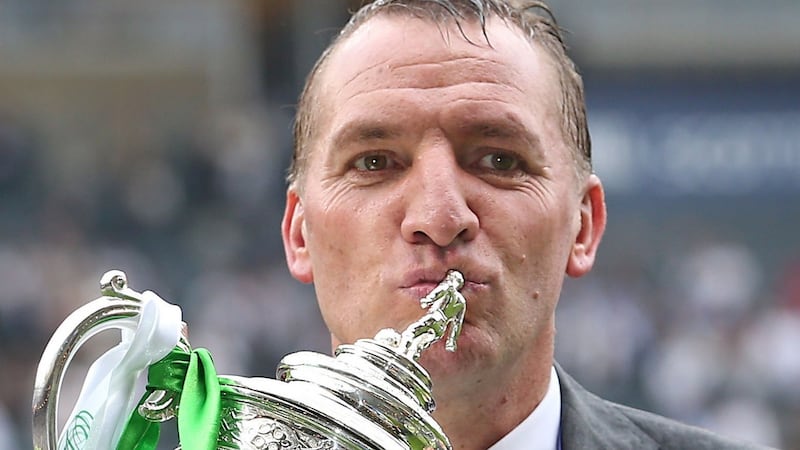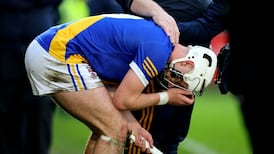On Saturday afternoon, I was lucky enough to see Celtic complete a once-in-a-lifetime season along with Marc-Anthony and Jimmy, our two sons.
For them, to be in Hampden Park on a day like that was magical. The atmosphere was spine-tingling and the city was buzzing.
I found myself thinking about the reason why Celtic accomplished what they did this year and kept returning to the first days and weeks when Brendan Rodgers walked into the club. It was still on my mind when I sat down to watch Tyrone-Derry on Sunday afternoon.
There is a connection in that both Brendan and Mickey Harte share, I feel, a razor-sharp and highly detailed vision of how their teams should play the game. In fact, I believe this year’s Tyrone team is coached to an even higher level than the three All-Ireland-winning teams that Mickey Harte put together.
There were a few things at play for Celtic this year. Everyone was keenly aware of the 50th anniversary of the Lisbon Lions. I have been fortunate to get to meet and know a few of those men.
John Clarke, for instance, works in Lennoxtown and often travels with us to U-20 games. I like to sit beside him on the bus and just listen to him talk about his life with the club. He talks about breaking into the team and the jobs they had to do as apprentices. John also has an interest in Gaelic games because he was raised in Limerick for a period of time when he was young.
So it felt as if there was a synergy between the Lions team and this year’s side for the past number of weeks. I feel that a lot of what the team achieved this year was helped by their awareness of the significance of the Lisbon team. And the biggest compliment they could give their predecessors was to be the best they could be. And they did that by going unbeaten, which no Celtic team ever did before.
Watching that unfold over the winter and to see a new manager, Brendan Rodgers, coming in and establishing his vision has been fascinating. He began inculcating that vision immediately.
From the initial meeting with the players to the intensity at training; the double sessions every day and the players’ response to that all set an immediate expectation. He created a culture of being very serious about success from the word go.
Elite level
All of his interactions with the staff and the way he set about pushing standards reinforced the idea of the club aspiring to an elite level. And then, obviously, the coaching is at the heart of all that. He has put processes in place for every facet of the game plan. So the ability to coach these processes at a deep level: where does that come from?
For me, Brendan is a person who has over a long period of time actively reflected on the game as he sees it. So it comes from that absolute clarity of his vision. And I feel this is a quality which differentiates the good from the great and also winners from second place.
Ultimately Celtic’s whole season came down to one game. The Scottish Cup final is a big day out anyhow but Celtic’s bid to remain unbeaten hinged on a result on Saturday. So the day was charged with excitement.
Everything you do in training comes to bear in the key moments of a season
And Aberdeen came with a very clear game plan themselves. Their focus was on the final third and the defensive third. They were adamant they would shut Celtic down by pushing three strikers up on Celtic’s central defenders. And they forced Craig Gordon, the Celtic goalkeeper, to kick long which meant a lot of 50-50 ball in the game and Aberdeen were very hungry for those second balls.
Interestingly, they gave up the middle third then and focused on the back third. They looked to keep their back four intact and then had their full backs man-marking the Celtic wingers before the ball came and also had their wingers marking the Celtic full backs.
So you had a situation where the Celtic winger Patrick Roberts only got the ball twice in the first half where he was in a position to take the full back on. Also, if our central defenders tried to push it out wide, that avenue was being cut off very quickly. So it prevented Celtic from building the game as they would have liked and forced them to clip the ball over the Aberdeen back four and to adjust to the fact that the normal passes weren’t available.
Aberdeen made it a different game of football. So it was interesting for me because I have been privy to a lot of what Brendan has been doing and we would try to implement those tactics and ideas at U-20 level.
And people around me at the cup final were saying: “we are not getting going”. But that was down to Aberdeen. And ultimately, that dynamic finds its way to the manager. So he has to retain his principles while finding a way to break down the challenge presented.
Winning goal
He did that by shifting the emphasis of attack more centrally. He had two number tens and a nine all trying to penetrate through the centre and he kept pushing players into more advanced positions. And eventually Aberdeen’s defenders got sucked in to cope with the various threats materialising there and critically the space then opened up on the flanks. You can see that Tom Rojic has all the space he needs to his right in the run that led to his winning goal.
The point here is that I think the reason the Celtic players were able to respond and implement those changes on what was the biggest game of their season goes back to those very first training sessions. It’s a universal truth in sport. Everything you do in training comes to bear in the key moments of a season. Without that, the tactics are impossible to implement.

And that is why I felt confident Celtic would find a way to win the game on Saturday. And it was fantastic just to be there and feel that outpouring of joy and to see a team realise that they had got the best out of themselves.
I think Mickey Harte has guided Tyrone to a similar sphere.
You could see that in Celtic Park on Sunday in all kinds of ways but one clear illustration was the difference in how both teams looked to win the ball. Tyrone used strategy whereas Derry used brawn and force and consequently gave up a lot of frees in the scoring area to Tyrone.
There was an incident when Ciaran McFaul and Carlos McWilliams committed to a tackle and remonstrated with the referee. I was thinking: that is a free all day long. Why are you complaining? Tyrone, Monaghan and Donegal rarely give up scoring chances like that. You can’t have intensity without discipline or you will be hurt with frees.
But what caught my attention about Tyrone was the offensive strategy. Gaelic football has changed and it continues to. That’s obvious. The teams that have best adapted to these changes are able to rack up big scores. There are more and more questions being asked of coaches now. But success very often boils down to detail and strategy.
Look at how Tyrone attack. As we could see, the support of the man on the ball was there in abundance: runners all around three and four deep. But it is the way they support that’s important. Tyrone attack by running, strong hard diagonal angles making it difficult for the defender to challenge them.
Fisted pass
If you watch Lionel Messi, he does the same thing. He runs at an angle across the face of the defender. Tyrone did this all day long against Derry. I think that is a tactic born out of rugby in terms of running lines. They are very fluent and efficient in moving the ball. And it is quite easy for them to time their run to come from the opposite side and then turn the point of attack completely. So they get into the final third of the opposition half frequently.
They are also using the fisted pass to the inside forward in a way that is patently coached. You can’t kick it inside very often anymore because it is very hard to find forwards. Dublin excel at this as well. The first few scores Tyrone achieved on Sunday took advantage of that fisted pass. It is a very clever and high percentage option. If Derry pushed out around the 45 then they looked to use that dink diagonal kick pass in behind them.
Their third option was a long early diagonal ball into the full forward line. And this mostly came when Derry pressed up. The last piece of the jigsaw was when Derry managed to slow them down and were well set up. Then it became about composure and the pace with which they moved the ball.
We spoke about Monaghan doing this also. Tyrone kept the ball out of contact and away from the Derry defenders and then Derry played into their hands by losing their discipline. And so you fall three, four, five points behind. Management teams need to understand why this happens. It’s not simply because the other team is inherently ‘better’.
Like Brendan Rodgers, Harte is squeezing every percentage possible out of the game plan. I am not saying his All-Ireland teams weren’t well coached; of course they were. But the level of coaching has been pushed to a deeper level now because the game is less open than it was in 2003 through to 2008.
Plus, Tyrone had several outstanding forwards and a once-in-a-generation player in Peter Canavan then. If you dropped those marquee forwards into their current squad – Canavan, McGuigan, O’Neill – then they would be incredibly hard to stop. They have leadership in Sean Cavanagh and Peter Harte.
I like Colum McCann. He offers height. I like the pace on the team and they have a quality bench. They move from defence to attack really smoothly. They have a very similar defensive set-up to Monaghan. They went man to man on the opposition forwards and then set up a defence five metres outside the 45. Based on the resources available to Mickey Harte, they are operating at peak capacity.
The question now is: how far can those processes take the team? Is it possible to win an All-Ireland based on this approach alone or do you need that x-factor forward to make the difference?











